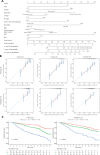Epstein-Barr virus DNA loads in the peripheral blood cells predict the survival of locoregionally-advanced nasopharyngeal carcinoma patients
- PMID: 33960178
- PMCID: PMC8330545
- DOI: 10.20892/j.issn.2095-3941.2020.0464
Epstein-Barr virus DNA loads in the peripheral blood cells predict the survival of locoregionally-advanced nasopharyngeal carcinoma patients
Abstract
Objective: Circulating cell-free Epstein-Barr virus (EBV) DNA has been shown to be a valuable biomarker for population screening and prognostic surveillance for nasopharyngeal carcinoma (NPC). Despite important insights into the biology of persistence, few studies have addressed the clinical significance of cell-based EBV-DNA loads in peripheral blood cells (PBCs).
Methods: A prospective observational cohort study was conducted involving 1,063 newly diagnosed, locoregionally-advanced NPC patients at Sun Yat-sen University Cancer Center from 2005 to 2007. Cox regression analysis was conducted to identify the association of PBC EBV DNA loads to overall survival (OS) and other prognostic outcomes. Prognostic nomograms were developed based on PBC EBV DNA loads to predict survival outcomes for NPC patients.
Results: After a median follow-up of 108 months, patients with higher PBC EBV-DNA loads had significantly worse OS [hazard ratio (HR) of medium, medium-high, and high vs. low were 1.50, 1.52, and 1.85 respectively; Ptrend < 0.001]. Similar results were found for progression-free survival and distant metastasis-free survival. The concordance index of the prognostic nomogram for predicting OS in the training set and validation set were 0.70 and 0.66, respectively. Our data showed that the PBC EBV DNA load was an independent and robust survival biomarker, which remained significant even after adjusting for plasma EBV DNA loads in a subset of 205 patients of the cohort (HR: 1.88; P = 0.025). Importantly, a combination of PBC EBV DNA load and plasma EBV DNA load improved the predicted OS.
Conclusions: The EBV-DNA load in PBCs may be an independent prognosis marker for NPC patients.
Keywords: Epstein-Barr virus DNA; Nasopharyngeal carcinoma; nomogram; peripheral blood cells; prognosis.
Copyright © 2021 Cancer Biology & Medicine.
Conflict of interest statement
No potential conflicts of interest are disclosed.
Figures



Similar articles
-
Prognostic significance of a combined and controlled nutritional status score and EBV-DNA in patients with advanced nasopharyngeal carcinoma: a long-term follow-up study.Cancer Biol Med. 2021 Jun 16;19(4):551-64. doi: 10.20892/j.issn.2095-3941.2020.0627. Cancer Biol Med. 2021. PMID: 34132505 Free PMC article.
-
Diagnostic performance of EBV DNA load testing for nasopharyngeal carcinoma in nasopharyngeal swab outperforms the approach in other specimens.BMC Cancer. 2025 Jul 1;25(1):1126. doi: 10.1186/s12885-025-14539-5. BMC Cancer. 2025. PMID: 40597842 Free PMC article.
-
Prognostic implications of EBER and EBV DNA combinations in nasopharyngeal carcinoma in endemic areas.BMC Oral Health. 2025 Aug 23;25(1):1361. doi: 10.1186/s12903-025-06733-5. BMC Oral Health. 2025. PMID: 40849665 Free PMC article.
-
The clinical utility of plasma Epstein-Barr virus DNA assays in nasopharyngeal carcinoma: the dawn of a new era?: a systematic review and meta-analysis of 7836 cases.Medicine (Baltimore). 2015 May;94(20):e845. doi: 10.1097/MD.0000000000000845. Medicine (Baltimore). 2015. PMID: 25997061 Free PMC article.
-
Impact of residual disease as a prognostic factor for survival in women with advanced epithelial ovarian cancer after primary surgery.Cochrane Database Syst Rev. 2022 Sep 26;9(9):CD015048. doi: 10.1002/14651858.CD015048.pub2. Cochrane Database Syst Rev. 2022. PMID: 36161421 Free PMC article.
Cited by
-
New insights into Epstein‑Barr virus‑associated tumors: Exosomes (Review).Oncol Rep. 2022 Jan;47(1):13. doi: 10.3892/or.2021.8224. Epub 2021 Nov 15. Oncol Rep. 2022. PMID: 34779497 Free PMC article. Review.
-
Epstein-Barr Virus is Associated with Gastric Cancer Precursor: Atrophic Gastritis.Int J Med Sci. 2022 May 21;19(5):924-931. doi: 10.7150/ijms.71820. eCollection 2022. Int J Med Sci. 2022. PMID: 35693736 Free PMC article.
-
An overall survival predictive nomogram to identify high-risk patients among locoregionally advanced nasopharyngeal carcinoma: Developed based on the SEER database and validated institutionally.Front Oncol. 2023 Mar 16;13:1083713. doi: 10.3389/fonc.2023.1083713. eCollection 2023. Front Oncol. 2023. PMID: 37007141 Free PMC article.
-
Genomic and microbial factors affect the prognosis of anti-pd-1 immunotherapy in nasopharyngeal carcinoma.Front Oncol. 2022 Aug 17;12:953884. doi: 10.3389/fonc.2022.953884. eCollection 2022. Front Oncol. 2022. PMID: 36059644 Free PMC article.
-
Recurrence risk stratification based on Epstein-Barr virus DNA to identify enlarged retropharyngeal lymph nodes of nasopharyngeal carcinoma: A model-histopathologic correlation study.Front Med (Lausanne). 2022 Dec 1;9:996127. doi: 10.3389/fmed.2022.996127. eCollection 2022. Front Med (Lausanne). 2022. PMID: 36530897 Free PMC article.
References
-
- Plummer M, de Martel C, Vignat J, Ferlay J, Bray F, Franceschi S. Global burden of cancers attributable to infections in 2012: a synthetic analysis. Lancet Glob Health. 2016;4:e609–16. - PubMed
-
- Klein G. Nasopharyngeal carcinoma (NPC) is an enigmatic tumor. Semin Cancer Biol. 2002;12:415–8. - PubMed
-
- Tao Q, Chan AT. Nasopharyngeal carcinoma: molecular pathogenesis and therapeutic developments. Expert Rev Mol Med. 2007;9:1–24. - PubMed
-
- Lee AW, Fee WE, Jr, Ng WT, Chan LK. Nasopharyngeal carcinoma: salvage of local recurrence. Oral Oncol. 2012;48:768–74. - PubMed
Grants and funding
- 2016YFC0902001/National Key Research and Development Program of China
- 81861138006/Sino-Sweden Joint Research Program
- 201804020094/Science and Technology Planning Project of Guangzhou, China
- 81973131/National Natural Science Foundation of China
- 81903395/National Natural Science Foundation of China
- 81803319/National Natural Science Foundation of China
- 81502056/National Natural Science Foundation of China
- 81325018/National Science Fund for Distinguished Young Scholars of China
- 81220108022/Key Project for International Cooperation and Exchange of the National Natural Science Foundation of China
- 2017A030312003/Natural Science Foundation of Guangdong Province
LinkOut - more resources
Full Text Sources
Other Literature Sources
